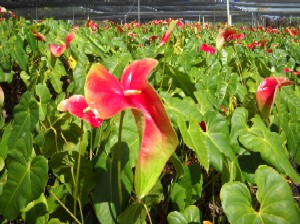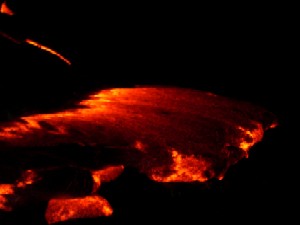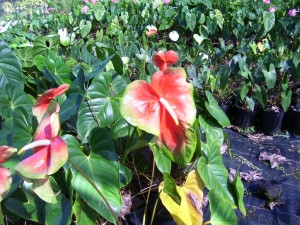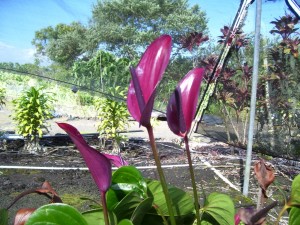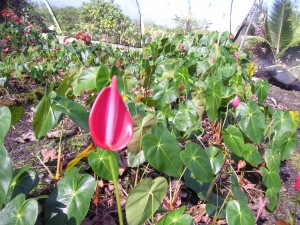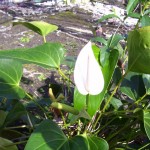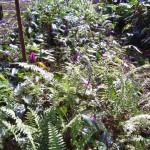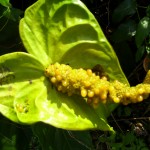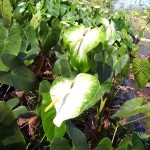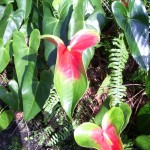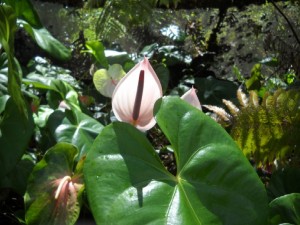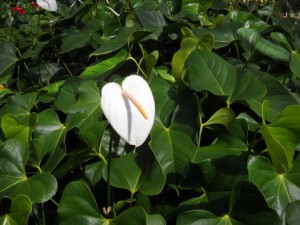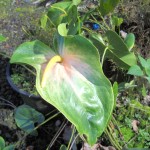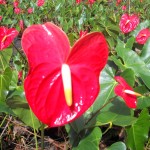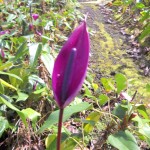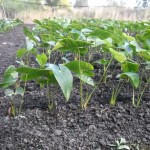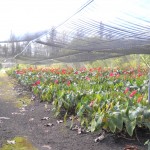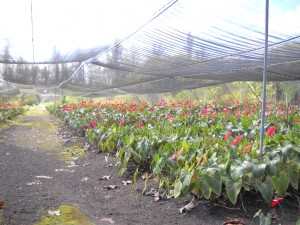Anthurium Flowers of Hawaii
Anthurium flowers aren’t native to Hawaii, but they have certainly made themselves at home here in our lush tropical paradise.
If you would like to buy anthurium flowers from Hawaii, please be sure to check out our anthurium flower catalog. But now, let’s get back to our story.
Anthurium Flowers: Where Do They Come From?
Before they decided to make a home for themselves among the volcanoes and beaches of Hawaii, anthuriums grew in the hot, humid rain forests of Central and South America. There they grew undisturbed for thousands of years.
Then one day in 1876 a man who would later become the head gardener of Paris, Edouard Andre, spotted a beautiful plant, while on a botanical expedition in the rain forests of Columbia.
It turned out that this plant was an anthurium plant.
How Did The Anthurium Get To Hawaii?
Edouard sent this magnificent specimen back to Europe and it first landed in Belgium. From Belgium, it was taken to the Kew Royal Botanic Gardens in England, (which claims to be one of the largest gardens in the world, containing one eighth of all the known plant species in the entire world.)
In 1889, Samuel Mills Damon, Hawaii’s Minister of Finance (and also Hawaii’s fourth largest landowner at the time) brought the first anthurium to Hawaii from England. He planted it in the gardens of his estate.
How The Anthurium Flower Developed in Hawaii
In the 1930s and 40s anthuriums spread from Damon’s estate all around Hawaii. Hobbyists began growing anthurium flowers in gardens and even their backyards, under Hapu’u tree ferns or tangerine trees.
The year 1936 was an important year for Hawaii’s anthurium flower industry. This was the year that a red anthurium which came to be known as the Ozaki was found in the garden O. Ozaki in the town of Hilo on the Big Island of Hawaii. At one point in time, the Ozaki was one of the best selling varieties of anthurium flowers from Hawaii.
1946 marked the discovery of a beautiful orange anthurium called the Nitta. It came from the garden of Asako Nitta and some say that is bears a striking resemblance to the original anthurium discovered by Edouard Andre.
In 1950, Haruyuki Kamemoto, returned to Hawaii after finishing his PhD at Cornell and launches the University of Hawaii‘s anthurium research program, which, as we will soon see, has a significant impact on the anthurium industry in Hawaii.
(As a side note, not only did Kamemoto have a huge impact on Hawaii’s anthurium industry, he also made major contributions to Hawaii’s orchid industry as well.)
1963 was another important year. It marked the release of the Uniwai white anthurium and the Marian Seefurth pink anthurium from the University of Hawaii. The Marian Seefurth anthurium was named after the wife of a man who made a very generous donation to the UH to fund anthurium research. These varieties were the first in a string of new anthurium varieties released by the University of Hawaii.
The Mauna Kea anthurium was released in 1977 by the UH. It is a large white and green obake anthurium variety.
In 1988, the first anthurium to be patented, the Starlight, which was developed by Calvin Hayashi, is introduced to Hawaii’s anthurium industry. It produces red flowers that are mottled with white specks. Mr. Hayashi also developed a dazzling green anthurium called the Midori.
In 1993, the University of Hawaii’s first patented anthurium is released. It is the Kalapana anthurium, which is a red and green obake anthurium flower. It is named after the magnificent black sand beach that was destroyed by a lava flow from the Kilauea Volcano.
Anthuriums on Amazon
Here are a few interesting anthurium related items that I saw on Amazon. I get a small commission from Amazon if you buy something through one of my links. The commission helps me to keep this site running and it doesn’t cost you any extra because Amazon already factors it into the price of all of its products.
Anthurium Flowers and Plants
ANTHURIUMS are one of the most beautiful flowers in the world. ANTHURIUM FLOWERS are produced by ANTHURIUM PLANTS, which are members of the genus ANTHURIUM. This genus consists of over eight hundred ANTHURIUM SPECIES and hybrids like OBAKE ANTHURIUM. ANTHURIUM CARE is easy and consists of finding the right place to put them and watering them properly. HAWAII is one of the first places in the world to grow anthuriums commercially.
Hawaii Flowers: Anthurium, Heliconia, Hibiscus and Orchid
Today I want to tell you about some of my favorite varieties of tropical flowers that grow here in Hawaii. As you well know, Hawaii is a tropical island that never experiences the snows of winter. In fact the temperature seldom drops below 65 degrees. Also, Hawaii has an abundance of sunshine and rain, making it the ideal environment for plants to grow. This ideal environment allows many beautiful varieties of flowers to thrive here.
Anthurium Flowers
The first of my favorite flowers are anthurium flowers. The anthurium was brought here more than a hundred years ago from South America. It produces a lovely flower in many different colors. I have seen colors from red all the way to purple. Most of the time, it is shaped like a heart, though some varieties may be shaped like a tulip. A majority of the varieties are unscented, but a few of the tulip varieties smell great.
Heliconias
Heliconias are some of the most exotic looking flowers in the world. You can just imagine how these flowers look, when one of the varieties has been nicknamed, lobster-claws. The can be found near Indonesia and in South America. But they also seem to enjoy growing in Hawaii. The often produce red, orange or yellow flowers in strange configurations.
Hibiscus
The Hibiscus plant grows all over the world, including in Hawaii. In fact, Hawaii has made the yellow Hibiscus its state flower. Out of all of the flowers that I am describing today, the Hibiscus is the flower with the most conventional shape. But that doesn’t mean that it isn’t a beautiful flower. It comes in many colors, including red, yellow, pink and white.
Orchid
Finally, the orchid is another of those flowers that seems to grow everywhere. But they definitely enjoy it here too. Next to the heliconia, they are one of the most exotic looking flowers. I like how they look almost carnivorous, like they could gobble up a bee that is trying to pollinate it. As far as I know, there is only one edible orchid, the vanilla orchid. And this is grown on Hawaii too.
Anthurium Amnicola aka Tulip Anthuriums
Tulip anthuriums originally hail from the tropical South American country of Panama. In the wild, they like to grow on boulders that are located next to streams. I guess they like hanging out by rivers, just like fly fishermen do.
They are a most excellent variety of anthurium, because they have a pleasant, swell-smelling fragrance and they can produce up to eight flowers a year. Furthermore, they make excellent indoor plants, because they are small and don’t take up a lot of room.
They are an interesting kind of anthurium because of the distinctive shape of their flowers. Instead of being heart shaped like most other anthuriums, they are tulip shaped. They have light purple petals and dark purple noses. I like how they are like tulips with a tropical ambiance. Pure-breed Amnicola produce small, dark-green, spade shaped leaves and small flowers with short stems that generally top out at twelve inches long.
Amnicola has frequently been hybridized with Anthurium Andraeanum to produce a variety of flower colors, which include: purple, red, pink, purple, green, fuschia, lavender and white. Pure-breed amnicola and hybrid amnicola can both produce up to eight flowers a year, so your amnicola could have flowers on it year round. It also produces offshoots quite readily, so it is ideal if you want to produce more plants. You can let the offshoots develop for a while and once they are big enough you can separate them from the parent plant and put them into their own pots.
Some of the hybrids can have interesting names such as Misty Pink, Lady Jane, Pink Elf, and Pink Champagne. Others have less creative names like: Andraecola-1 and Andraecola-2 that were created by taking the first part of Andraeanum and the last part of Amnicola and putting them together. Of course these will probably be given other names at some point.
Amnicola Pictures
Anthuriums
The genus Anthurium is a member of the family Araceae and may consist of up to 1,000 species. Since the members of this genus grow in the Amazon rainforest, which has yet to be fully explored, many new species continue to be discovered each year. Some people mistakenly believe that this genus is also native to Asia, but plants found there appear to have been introduced by humans.
Members of this genus grow in tropical rain forests that receive abundant rain fall. They can be found growing on the ground or on trees. They can grow in many forms, but the most prevalent forms are bushes or vines, attached to trees. They can grow from seeds or as offshoots of parent plants. Offshoots are genetically identical to parent plants, while seeds, even if produced by self-pollination may not be exactly identical to their parent.
All members of Araceae produce an inflorescence or spadix, where both male and female portions of the flower are present. Self pollination does not occur, unless a plant produces multiple flowers at different times because the stigma and the stamen are active at different times. The spadix is surrounded by a spathe, a modified leaf, which is mistakenly thought to be the flower by some, whereas the spadix is the true flower of the anthurium.
Anthuriums may be grown for their leaves or for their flowers. They can be grown outdoors in tropical climates or indoors in colder climates. Warmer temperatures, 65 to 80 degrees, are required, and freezing temperatures will damage these plants. They grow well in moist, but not saturated soil, with a lot of humus. Direct sunlight will harm them, so keep them in bright indirect light.
They are most commonly propagated by taking cuttings. A cutting should have at least two growing nodes that consist of bunches of roots and leaves. It should be placed in a mix of peat moss and perlite or sand and watered regularly. They may also be propagated by seed, but the production of seed will often require an expert’s skill and patience; since the process from pollination to seedling may take up to a year and a half.
Obake Anthurium Flowers
In Japanese, the word obake means “a thing that changes” and it can also be translated as “ghost”. Obake anthurium flowers (which are sometimes miss-spelled obaki) could easily have received their name from either translation. They usually come in a mix of colors, so it is easy to see that their coloration could be “a thing that changes.” In addition, they are large flowers with a wavy surface, which gives them an otherworldly or ghostly feel. Here are some of my favorite types of obake anthuriums.
Tropic Sunrise
Tropic Sunrise is a very popular orange obake anthurium. It is a large flower with an orange center, surrounded by green edges, which was developed by the University of Hawaii. H. Kanemoto created it by crossing an Anuenue with a Soga Orange Obake back in 1981.
Mauna Loa
Mauna Loa is a stunning white obake anthurium flower. It possesses a white core with a green perimeter. Mauna Loa was created from an open pollinated Tropic Ice, which means that we don’t know which variety supplied the pollen to produce this strain. In addition, it has an outstanding 56 day vase life if placed in water immediately after harvest.
Other beautiful white obake varieties include Tropic Ice, Pearl and Rainbow Obake. The Rainbow Obake is particularly beautiful, because instead of having only two colors, it has three colors. It is white in the center, has green edges and it has pink veins. Pink obake varieties include the Anuenue Obake, Kimi Obake and Watermelo Obake.
Red Obake Varieties
There are a number of red obake varieties, most have a red core surrounded by green edges. They include the Kalapana Obake, Charade Obake, Madame Pele and the Oshiro Red Obake. The Kalapana is named after a region in Hawaii that was known for having a beautiful black sand beach that was covered by a lava flow from Kilauea Volcano, which according to Hawaiian legends is the home of volcano goddess Pele, whom the Madame Pele Obake is named after.
Buying Obake Anthuriums
When you are looking to buy flowers or obake anthurium plants be prepared to pay more. These flowers are much larger and much showier than standard varieties and they are also much rarer, so naturally they are going to cost more. So if they are more expensive, don’t be alarmed. However, you will get good value for you money as these flowers look amazing and come in some very special color combinations.
If you plan on buying obake plants, just make sure you know what you are doing when it comes to anthurium care. Obake anthuriums are harder to grow than other varieties. Their large flowers and leaves make them more vulnerable to pests, diseases and the elements.
Anthurium Damage
Sometimes due to circumstances that are beyond our control, anthurium plants can sustain damage.
At times the cause of the damage may be an over-zealous pet and at other times it may be a young child with a pair of scissors.
Sometimes, the anthurium damage may even be caused by an act of God.
In fact, about twenty years ago, our anthurium farm was hit by a twister. Now twisters may be common in the Midwest, but they are very rare in Hawaii. This force of nature folded the three inch steel pipes that we used to build our shade houses in half, as if they were sheets of paper.
But despite the damage very few plants were lost on our farm.
Anthurium plants have remarkable regenerative capabilities and can often bounce back from terrible damage if given the proper care.
If your plant has sustained damage, even if it looks very bad, I would still recommend that you continue to care for it and give it a chance to recover.
Anthuriums remind me of starfish.
I’m sure that you probably heard the story about the crown of thorns starfish. A single one of these starfish destroys about 65 square feet of coral reef each year.
Many years ago, divers would cut them in half to try to kill them. Then they would toss each half back into the ocean.
But after they did this the starfish population exploded. It turns out that each half grew into a new starfish.
Anthuriums are kind of like that. Often when they are damaged and even cut in half, as long as each half possesses a node or two, each half can recover and develop into two plants.
So even if your anthurium is severely damaged or even cut in half, just make sure that you immediately plant any pieces of your damaged anthurium into a good potting soil. And then remember to water it diligently. Damaged anthuriums are much more sensitive to dehydration, especially if they are missing part of their root system.
With a little luck, your anthurium plant will recover and you may even end up going from having one anthurium plant to having two of them.
Anthurium Flower Overview
Anthurium flowers come in many different shapes and sizes. I’m sure that you could find hundreds of different kinds of flower variations. But there are just three main types of anthurium flowers: obake, tulip and standard. These classifications are based on the shape and the color pattern of each flower.
Obake Anthurium Flowers
Obake means “ghost” in the Japanese language. Since many of the earliest anthurium growers in Hawaii were Japanese, I guess it makes sense that this type of anthurium flower would receive a Japanese name. But what is less clear is why they chose to name these types of flowers “ghost.” Perhaps, it is because these beautiful, large flowers have an ethereal quality. Obake also has a second meaning in Japanese. It can also mean “a thing that changes” or something that is in transition. Perhaps the change from one color to another that is present in all obake flowers meets this definition.
Click Here To See Our Anthurium Flower Catalog.
Obake anthuriums are, in my opinion, the most stunning type of anthurium flowers. They produce the largest flowers and they rarely found in a single boring color, but instead are multi-colored. Each flower will often have one color in the center and a different color at their edges. They are shaped like elongated hearts and their spathe is often a little wavy. They are the most expensive variety to purchase, so I guess others feel the same way that I do about them.
Tulip Anthurium Flowers
Tulip anthuriums are shaped like tulips. Hopefully this isn’t a big surprise. They tend to be the smallest variety, often producing flowers that are only two to six inches in size.
They come in a range of colors including red, pink, purple, lavender and white. Unlike other types of anthuriums, some varieties of tulip anthuriums produce a pleasant, sweet scent. Unfortunately, their fragrance doesn’t always seem to last when they shipped as a cut flower. So you may need to find a tulip anthurium plant that is in bloom to experience their pleasing fragrance for yourself.
Standard Anthurium Flowers
Standard anthuriums are the oldest and most common variety of anthurium. They are what most people think of when the word anthurium is mentioned. They are shaped like perfect Valentine’s Day hearts and the majority come in solid colors, thought a minority come in multi-colored patterns. They typically range in size from three to eight inches and the most famous color is red. Though they can also come in orange, green, pink, various pastels and purple. Multi-colored varieties can have an obake-like color pattern or they can also be speckled.
Pictures From Our Farm
Here are a few pictures of the anthurium flowers that live on our farm. Would you believe that some of these anthurium plants are almost as old as I am? Well it’s true, if they aren’t harmed by injury or disease, anthurium plants can outlive us. We take top cuttings, plant them, let them grow for a few years and take top cuttings again, and this cycle repeats almost endlessly.
A Common Mistake When Ordering Anthurium Flowers
When ordering anthuriums for the first time, a common mistake is to not know exactly what is being ordered. Often, people will see a picture perfect anthurium bouquet or arrangement on a website and expect that this arrangement is exactly what they are going to be getting. But when it finally arrives and they open the box they are disappointed to find a bunch of loose flowers that they have to arrange on their own. To guard against making this mistake, check with the retailer to find out if they are selling loose flowers or actual arrangements.
Trivia
- Anthurium means “tail flower” in the Greek language
- Samuel Damon brought the anthurium to Hawaii in 1889
- The rain forests of Central and South America were the ancestral home of anthurium plants
- Anthurium plants can be mildly poisonous, they can cause stomach issues if ingested
- There are more than 800 species of anthuriums
- Virtually all anthurium flowers are of the species Anthurium Andreanum, this includes: obake, tulip and standard anthuriums in nearly every color of the rainbow
- Anthurium flowers are perfect, meaning that they have both male and female parts
Little Known Facts About Anthurium Flowers
What you think of as anthurium flowers really aren’t flowers at all, they are actually spathes. A spathe is really just a specialized leaf, or in other words, a bract, which is essentially a cross between a petal and a leaf. The spathe can come in almost all of the colors of the rainbow, from red to violet and it can also come in a variety of shapes, from the standard heart shape to the tulip shape.
In the center of the spathe, is where the real anthurium flower resides. This is where the spadix, a.k.a.: nose, tail or inflorescence is located. The spadix is the actual anthurium flower; it is where the stamen (male part of the flower) and stigma (female part of the flower) are to be found. The stamen and stigma can only be seen with magnifying glasses and appear as tiny bumps on the spadix.
In summary, the anthurium flower consists of the following parts. The spathe, which everyone calls a flower, but which is actually just a glorified leaf; the spadix, which is the actual flower; and the stigma and stamen, which are the female and male parts of the flower that appear as tiny bumps.
Anthurium Plants
There are just two major categories of anthuriums that you may find in your local plant store: foliage varieties and flowering varieties. And the vast majority of what you see will there will be flowering varieties.
As far as foliage varieties go, the main types are Anthurium Crystallinum and Anthurium Faustinomirandae. A. Crystallinum will typically produce dark green, smooth leaves with highlighted white veins that are up to two feet in size. While, A. Faustinomirandae will often produce monstrous five foot leaves that are stiff as paperboard. But good luck finding these in your garden store, these will take a little effort to procure.
In terms of flowering varieties the two main varieties are Anthurium Scherzerianum and Anthurium Andreanum. A. Scherzerianum is a tough plant and it is an excellent choice for your first anthurium plant as it is easy to care for and tough to kill. But it leaves much to be desired in terms of the types of flowers that it produces, which are rather limited. It usually produces small white flowers with a curly orange spadix and it has smaller spade shaped leaves.
If you want the widest possible choice in flower shapes, sizes and colors, look to A. Andreanum. It is the species that is responsible for virtually all of the various types of anthurium flowers that are found in flower shops. In Hawaii, in the 1940’s, anthurium hobbyists learned how to selectively breed anthuriums. The fruit of their efforts was an explosion of different types of A. Andreanum flowers. They produced the three main flower shapes: standard, obake and tulips. And they also created many of the colors that we see today: red, orange, green, purple, pink, pastels, speckled and much, much more.
How To Care For Anthuriums
Anthuriums are strong plants and they are relatively easy to care for. There is really just two things that you need to do.
First, you need to water your plant regularly. It is critical that you give your anthurium enough water to keep it hydrated and do not give it so much water that it drowns. Ideally, you should water your plant every day, but you need to make sure that its soil drains well. You never want it to be left sitting it water. The water must drain away to allow oxygen to reach its roots. If oxygen does not reach its roots, anaerobic bacteria start to grow and will attack the root system of your plant.
Second, you need to fertilize your anthurium. The ideal way to do this is to use a very dilute liquid fertilizer once a week. But this is really too way too much work and the easier solution is to apply a slow release fertilizer every three to six months. This is much easier and produces close to the same results as the liquid fertilizer method.
Proper Growing Conditions For Anthuriums
You have to keep in mind that anthuriums come from tropical rain forests, so you’ll want to replicate this environment as closely as possible when you are growing an anthurium plant. To do this you’ll need high humidity, warm temperatures and filtered sunlight.
The ideal place to meet these conditions is a window in your bathroom. When you take a hot shower, this will produce a lot of humidity. So the first necessary condition is fulfilled. By keeping your plant in your home you will generally meet the second condition which is a warm, but not excessively hot temperature. Anthuriums love temperatures of 70 to 80 degrees and they will be happy if you keep your home at this temperature. Finally, putting your plant near a window will give it filtered sunlight. Anthuriums like a lot of light, but too much light can cause their leaves to burn. Just put your plant as close to the window as you can, without it burning.







